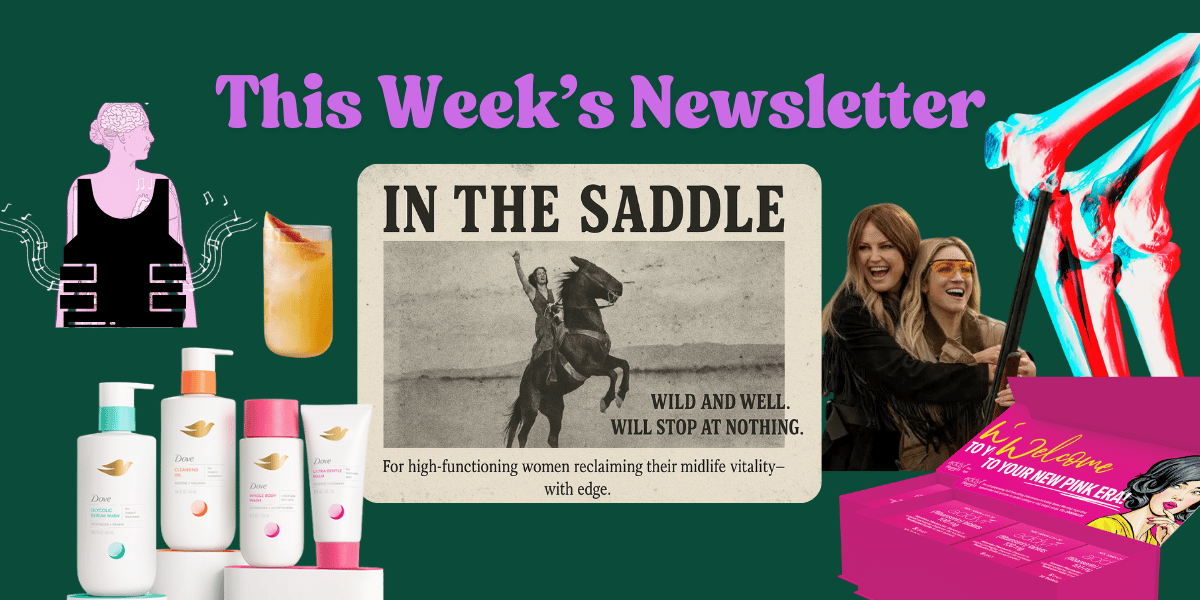
Jackie's Take: What's on My Mind in Women's Wellness ✍ 🤔 📰
Bone Gains, Not Back Pain: What Weighted Vests Can (and Can’t) Do— and Why it Seems Like Everyone is Wearing One
A couple of weeks ago I was at a book signing, chatting about everything from hot flashes to hemorrhoids, when the moderator lobbed an unexpected question:
“So… weighted vests. Hot or hype?”
You could practically hear the collective eye-roll. Fitness enthusiasts, nutritionists, and a few docs in the room erupted in equal parts laughter and side-eye. Apparently, nothing gets a midlife crowd going like strapping on ten pounds of neoprene and sand.
It’s not surprising. Weighted vests are having a moment, especially in the menopause corner of the internet. Influencers are walking their dogs in them, doctors are posting squat videos, and Amazon’s algorithm now thinks I have a fetish for tactical gear. But is there real science here, or are we just turning ourselves into walking sandbags to feel productive? 😵💫
The Research (or Lack Thereof)
First, let’s clear up the data. The recent study making headlines looked at dieting seniors—women in their late 60s, to be precise—and found that wearing weighted vests didn’t prevent hip bone loss during intentional weight loss. Nearly all published studies on vests and bone density have focused on postmenopausal women aged 60+, including one 5-year trial that showed preserved hip bone density with long-term use.
That’s useful, but it leaves a gaping hole for those of us in our 40s and 50s.
In practice, many women are now getting DEXA scans in their late 40s and showing early osteopenia, well before the guideline-recommended age of 65. That shift is controversial, but it speaks volumes: women want to intervene early, before there’s irreversible loss.
So while we don’t yet have randomized trials on vest use in women 35–60, the mechanical loading principle still applies. Stress your bones—through lifting heavy, jumping, or wearing external weight—and you tell them to stay strong. Weighted vests are a logical tool. We just need more data in this younger midlife cohort.
Why the Hype Now?
Here’s a stat that usually stops women in their tracks: osteoporosis leads to more hospitalizations in women than heart attacks, strokes, or breast cancer—combined.
The sudden popularity of weighted vests isn’t just because influencers look cute in them. It’s part of a larger menopause-fueled shift: we’re finally acknowledging bone loss as a major threat, not just a future inevitability.
There’s also something symbolic happening. After decades of being told to shrink ourselves, there’s power in literally adding weight. Midlife messaging is evolving from “slow down” to “build up.” That reframing which has been heavily driven by social media, has made strength and musculoskeletal health feel visible, urgent, and deeply personal.
My Take on Wearing One
Yes, I’ve worn a weighted vest. I use it for uphill walks or bodyweight squats, and I like it as a low-barrier way to add load and increase my heart rate. It’s especially helpful for women who aren’t ready (or willing) to pick up a barbell. That said, it’s not a substitute for progressive resistance training.
But not every body is a great candidate off the bat.
If you have osteopenia, osteoporosis, chronic neck or shoulder pain, or if you’re not rock solid in your postural alignment, a weighted vest can actually backfire. Instead of reinforcing strength, it can exacerbate misalignment, contribute to spinal compression, or even lead to injury.
In those cases I always recommend getting medical clearance first, often from a physical therapist or clinician familiar with bone health. And if you get the green light? Start light. I’m talking 4–6 pounds max. Ensure the vest fits snugly and distributes weight evenly, then progress gradually based on how your body responds.
The Hormone Connection & Technical Details
Here’s the nerdy part. Estrogen isn’t just about hot flashes. It’s an anabolic hormone that preserves muscle and fuels the osteoblasts (the cells that build bone). As estrogen declines in perimenopause and menopause, women lose lean muscle and bone density more rapidly. Muscle mass affects insulin sensitivity, inflammation, and energy. Bone loss raises the risk of fractures that can significantly alter quality of life.
And rapid weight loss—whether from under-eating, illness, or GLP-1s—can erode bone. Women can lose 1–2% of bone mass for every 10% of body weight lost. Not small potatoes.
Weight-bearing and resistance training can be a key tactic to mitigate this decline. Weighted vests add mechanical load to the skeleton, stimulating osteoblast activity and increasing the challenge of otherwise low-impact movements like walking or squats.
But let’s be clear: they’re one tool—not the tool.
They don’t replace heavy lifting, plyometrics, or cardio. They complement those things. For women just starting out, they can be a smart bridge to more advanced training. For others, they’re a way to increase daily load during walking, errands, or standing desk life.
Bottom Line
Weighted vests are a clever addition to the midlife toolbox. They make walks and bodyweight exercises more effective and offer a sense of control during a time when our bodies can feel like they’re betraying us.
But they’re not a magic bullet. Bone and muscle health in midlife require a comprehensive approach: heavy lifting, dynamic movement, adequate protein, hormone support when indicated, and yes, sometimes just moving your body in literally ANY way that brings you joy💃

Gif by lizaanne on Giphy
This Serum Reduces Wrinkles in Just 10 Minutes!
Medik8's best-selling Liquid Peptides Advanced MP face serum is clinically proven to diminish the appearance of expression lines in 10 minutes & deep-set wrinkles in 8 weeks*. Powered by a breakthrough peptide technology, Dual MiniProteins™, to target the foundation of visible wrinkles.
*Proven via independent clinical study on Liquid Peptides Advanced MP tested on 34 participants at 10 minutes & 8 weeks
The Tea: What's Trending in Women's Wellness & Culture 🍵 🛍
Insurance wasn’t designed for women in midlife and if you’ve been to your obgyn lately, you already know. This article lays out some of the creative, real-world ways we’re getting the care we actually need: from HSAs and wellness stipends to cash-pay clinics and telehealth platforms. I’m seeing more and more of you go this route, and frankly… same.🩺 (Flow Space)
This author does a great job telling the story of ovarian aging and why it matters for your whole-body health, with graphs and visuals that make it click (essential if you're a visual learner like me). It’s a powerful reminder that our ovaries are doing way more than managing fertility, and their decline has ripple effects on everything from bone to brain to metabolism. 📊 (USA Today)
You probably haven’t heard of Addyi—and that’s kind of the problem. It was the first FDA-approved, non-hormonal pill for low sexual desire in women, and it’s now making its way into medspas. As sexual wellness gets folded into the aesthetics-meets-metabolism boom, Addyi is being positioned as the next “essential” in your midlife toolkit right alongside GLP-1s, HRT, and your crow’s feet touch-up. (Beauty Independent) 🔻⬇
And that begs the question… 👇
I'm dying to know - where/with whom would you feel most comfortable talking about low desire?
“The next big beauty product isn’t a blush called Orgasm, it’s an orgasm itself.”
This Week on The Well Kept Podcast🎙
The Shift From Longevity to Healthspan🫀⌛
“Longevity for women isn't the same as longevity for men. We need to stop pretending it is." 🎧
Our conversation this week is one of our BEST. We discuss all things female longevity and biohacking including:
✨ Why women's longevity requires triple the clinical sophistication
✨ How perimenopause is THE inflection point for chronic disease
✨ Why your personality type affects your wellness journey
✨ The difference between longevity theater and actual transformation
Listen below for a clip, and on Spotify for the Full Episode →🎙
The Group Chat Edit 📲 👯♂
📺 To Watch: The Hunting Wives on Netflix 🤠
It’s spicy. It’s murderous. It’s perfectly timed summer soapy smut.🫧🌶
🛍 To Buy: These new Dove Body Products
The Dove Self-Esteem Project is known for attacking beauty anxiety and stigma head on— especially in younger girls. But their new line of perimenopause body products is taking aim at a different demographic, and everything is $20. 💵
🥥 To Try: This Coconut Paloma 🍹
Coconut water in the shaker AND in the ice cubes. A perfect summer sip IMO. 😋🧊
☀ A Quick Note to my In the Saddle Subscribers:
August is slipping away like a moment in time (yes, that “August”). So I’m taking my own advice (hard as that may be for us Enneagram 3’s) and logging off to focus on my HRV, my beach playlist, and my people.🧒
There won’t be a newsletter next week, but I encourage you to do something radical: read a paper book. We’ll be back in your inbox on August 21 with something special we’ve been cooking up and trust me, you’ll want to be there for it. 🐚📖✨
Saddle Up & Spread the Word 🏇💨

If you’re still reading, thank you. In the early days of a business, every subscribe, like, and share makes a real difference. Your early support means so much as I keep building In the Saddle - both the newsletter and this community ⭕
To share — Just click and copy this link: https://inthesaddle.beehiiv.com/
If you’re a brand, expert, or just someone with an excellent story to tell in the wellness, longevity, or sexual health space, I’d love to connect! I am always open to hearing ideas for ITS content and collabs. ✏️ 🏇🔥
With gratitude always,
Jackie Giannelli, FNP-BC, MSCP
Founder, In the Saddle
What did you think of today's newsletter?
Medical Disclaimer:
The content provided in this newsletter is for informational and educational purposes only and is not intended as a substitute for professional medical advice, diagnosis, or treatment. Nothing contained herein should be construed as medical guidance or the practice of medicine. You should always seek the advice of your physician or other qualified healthcare provider with any questions you may have regarding a medical condition or treatment. Never disregard professional medical advice or delay seeking care because of something you read in this newsletter. Use of the information provided is at your own risk. No clinician-patient relationship is formed through this content.










